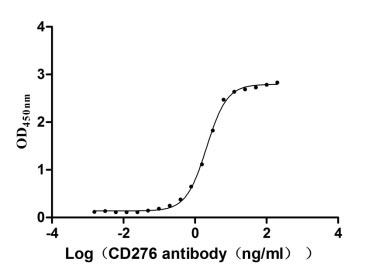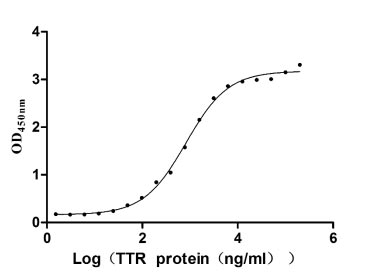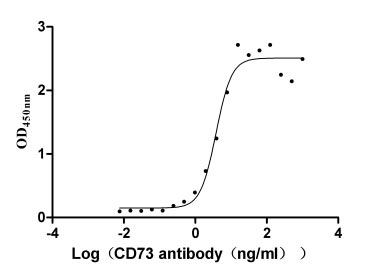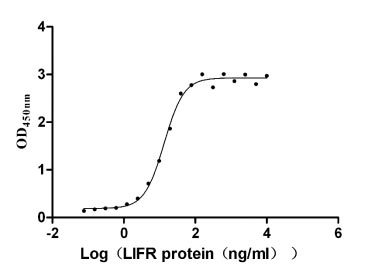Recombinant Human Mitochondrial antiviral-signaling protein (MAVS), partial
-
货号:CSB-YP772018HU
-
规格:
-
来源:Yeast
-
其他:
-
货号:CSB-EP772018HU
-
规格:
-
来源:E.coli
-
其他:
-
货号:CSB-BP772018HU
-
规格:
-
来源:Baculovirus
-
其他:
-
货号:CSB-MP772018HU
-
规格:
-
来源:Mammalian cell
-
其他:
产品详情
-
纯度:>85% (SDS-PAGE)
-
基因名:
-
Uniprot No.:
-
别名:CARD adapter inducing interferon beta; CARD adaptor inducing IFN beta; Cardif; DKFZp666M015; FLJ27482; FLJ41962; IFN B promoter stimulator 1; Interferon beta promoter stimulator protein 1; Ips 1; IPS-1; Ips1; KIAA1271; MAVS; MAVS_HUMAN; Mitochondrial anti viral signaling protein; Mitochondrial Antiviral Signaling; Mitochondrial antiviral signaling protein; Mitochondrial antiviral-signaling protein; Putative NF kappa B activating protein 031N; Putative NF-kappa-B-activating protein 031N; Virus induced signaling adapter; virus induced signaling adaptor; Virus-induced-signaling adapter; VISA
-
种属:Homo sapiens (Human)
-
蛋白长度:Partial
-
蛋白标签:Tag type will be determined during the manufacturing process.
The tag type will be determined during production process. If you have specified tag type, please tell us and we will develop the specified tag preferentially. -
产品提供形式:Lyophilized powder
Note: We will preferentially ship the format that we have in stock, however, if you have any special requirement for the format, please remark your requirement when placing the order, we will prepare according to your demand. -
复溶:We recommend that this vial be briefly centrifuged prior to opening to bring the contents to the bottom. Please reconstitute protein in deionized sterile water to a concentration of 0.1-1.0 mg/mL.We recommend to add 5-50% of glycerol (final concentration) and aliquot for long-term storage at -20℃/-80℃. Our default final concentration of glycerol is 50%. Customers could use it as reference.
-
储存条件:Store at -20°C/-80°C upon receipt, aliquoting is necessary for mutiple use. Avoid repeated freeze-thaw cycles.
-
保质期:The shelf life is related to many factors, storage state, buffer ingredients, storage temperature and the stability of the protein itself.
Generally, the shelf life of liquid form is 6 months at -20°C/-80°C. The shelf life of lyophilized form is 12 months at -20°C/-80°C. -
货期:Delivery time may differ from different purchasing way or location, please kindly consult your local distributors for specific delivery time.Note: All of our proteins are default shipped with normal blue ice packs, if you request to ship with dry ice, please communicate with us in advance and extra fees will be charged.
-
注意事项:Repeated freezing and thawing is not recommended. Store working aliquots at 4°C for up to one week.
-
Datasheet :Please contact us to get it.
相关产品
靶点详情
-
功能:Required for innate immune defense against viruses. Acts downstream of DHX33, DDX58/RIG-I and IFIH1/MDA5, which detect intracellular dsRNA produced during viral replication, to coordinate pathways leading to the activation of NF-kappa-B, IRF3 and IRF7, and to the subsequent induction of antiviral cytokines such as IFNB and RANTES (CCL5). Peroxisomal and mitochondrial MAVS act sequentially to create an antiviral cellular state. Upon viral infection, peroxisomal MAVS induces the rapid interferon-independent expression of defense factors that provide short-term protection, whereas mitochondrial MAVS activates an interferon-dependent signaling pathway with delayed kinetics, which amplifies and stabilizes the antiviral response. May activate the same pathways following detection of extracellular dsRNA by TLR3. May protect cells from apoptosis.
-
基因功能参考文献:
- The mitochondrial antiviral signaling adaptor protein (MAVS) oligomers and high MW aggregates coexist upon constitutively active retinoic acid-inducible gene I (RIG-I) ectopic expression and virus infection. Anchoring of MAVS to intracellular membranes is essential for an appropriate polymerization process allowing functional high MW aggregates to occur. PMID: 29385716
- MAVS isoforms are truncated, which prevents its spontaneous aggregation in antiviral innate immune signalling PMID: 28607490
- these results demonstrated that HAUS8 may function as a positive regulator of RLRVISA dependent antiviral signaling by targeting the VISA complex, providing a novel regulatory mechanism of antiviral responses PMID: 29916539
- results suggest that ASC, as a negative regulator of the MAVS-mediated innate immunity, may play an important role in host protection upon virus infection PMID: 29280086
- Using MAVS as a platform, NLRP11 degrades TRAF6 to attenuate the production of type I IFNs as well as virus-induced apoptosis. Our findings reveal the regulatory role of NLRP11 in antiviral immunity by disrupting MAVS signalosome. PMID: 29097393
- Low MAVS expression is associated with RNA virus infections. PMID: 29743353
- The down regulation of TRIF, TLR3, and mitochondrial antiviral signaling protein (MAVS) expressions in chronic hepatitis C correlates with the disease severity and the outcome of hepatitis C virus infection PMID: 28480979
- Taken together, these findings reveal an essential role of CypA in boosting RIG-I-mediated antiviral immune responses by controlling the ubiquitination of RIG-I and MAVS. PMID: 28594325
- Data show that human cytomegalovirus (HCMV; human betaherpesvirus 5) glycoprotein US9 inhibits the IFN-beta response by targeting the mitochondrial antiviral-signaling protein (MAVS) and stimulator of interferon genes (STING)-mediated signaling pathways. PMID: 29317664
- our results demonstrate that miR-22 negatively regulates poly(I:C)-induced production of type I interferon and inflammatory cytokines via targeting MAVS. PMID: 27705941
- this analysis did not indicate the association of the MAVS locus with susceptibility to Addison's disease and type 1 diabetes PMID: 27652379
- In the late phase of RNA viral infection, iRhom2 mediates proteasome-dependent degradation of the E3 ubiquitin ligase MARCH5 and impairs mitochondria-associated degradation (MAD) of VISA. PMID: 29155878
- findings suggest that oxidative stress-induced MAVS oligomerization in SLE patients may contribute to the type I IFN signature that is characteristic of this syndrome. PMID: 27899525
- findings reveal a negative feedback loop of RLR signaling generated by Tetherin-MARCH8-MAVS-NDP52 axis and provide insights into a better understanding of the crosstalk between selective autophagy and optimal deactivation of type I IFN signaling. PMID: 28965816
- Studied association of genetic variants of the MAVS, MITA and MFN2 genes with leprosy in Han Chinese from Southwest China; found no association between the variants and susceptibility to leprosy. PMID: 27553710
- Mechanistic studies showed that HACE1 exerts its inhibitory role on virus-induced signaling by disrupting the MAVS-TRAF3 complex. PMID: 27213432
- this study shows that keratinocytes are an important source of IFN-beta and MAVS is critical to this function, and demonstrates how the epidermis triggers unwanted skin inflammation under disease conditions PMID: 27438769
- Herpes simplex virus 1 blocks MAVS-Pex mediated early interferon-stimulated gene activation through VP16 to dampen the immediate early antiviral innate immunity signaling from peroxisomes. PMID: 28222744
- This study demonstrates a novel pathway for elevated IFNbeta signaling in SLE that is not dependent on stimulation by immune complexes but rather is cell intrinsic and critically mediated by IFNbeta and MAVS. PMID: 28471483
- TTLL12 as a negative regulator of RNA-virus-induced type I IFN expression by inhibiting the interaction of VISA with other proteins. PMID: 28011935
- Therefore, Seneca Valley virus suppressed antiviral interferon production to escape host antiviral innate immune responses by cleaving host adaptor molecules MAVS, TRIF, and TANK by its 3C protease. PMID: 28566380
- GPATCH3 interacts with VISA and disrupts the assembly of virus-induced VISA signalosome therefore acts as a negative regulator of RLR-mediated innate antiviral immune responses. PMID: 28414768
- this study shows that MAVS silencing upregulates IFN-beta production via upregulation of NF-kappaB and IRF3 signaling PMID: 27593154
- DDX3 directly regulates TRAF3 ubiquitination and acts as a scaffold to co-ordinate assembly of signaling complexes downstream from MAVS. PMID: 27980081
- this study identified three single nucleotide polymorphisms within MAVS that showed significant differences in plasma HIV-1 viral load PMID: 28024153
- Results indicate that TAX1BP1 functions as an adaptor molecule for Itch to target MAVS during RNA virus infection and thus restrict virus-induced apoptosis. PMID: 27736772
- Deficiency of MAVS in hematopoietic cells resulted in increased mortality and delayed West Nile Virus clearance from the brain. PMID: 27226371
- Can activate the RLR/MAVS pathway. PMID: 27605671
- deliberately targeting the evolutionarily conserved MDA-5-IPS-1 antiviral pathway in tumors can provoke parallel tumoricidal and immunostimulatory effects that bridge innate and adaptive immune responses for the therapeutic treatment of cancer PMID: 26893477
- Pyruvate carboxylase activates the RIG-I-like receptor-mediated antiviral immune response by targeting the MAVS signalosome. PMID: 26906558
- This study identified new functional alterations in antiviral signalling based on MAVS polymorphisms PMID: 26954674
- Data show that the NS3 protein of dengue virus bound to 14-3-3 epsilon protein (14-3-3varepsilon) and prevented translocation of retinoic acid-inducible gene-I protein (RIG-I) to the adaptor MAVS protein and thereby blocked antiviral signaling. PMID: 26998762
- These results demonstrate that poliovirus infection actively suppresses the host type I interferon response by blocking activation of IRF-3 and suggests that this is not mediated by cleavage of MDA-5 or IPS-1. PMID: 26437794
- Results show MAVS-transmembrane domain is shown to oligomerize in response to changes in the outer mitochondrial lipid membrane properties caused by treatment with mitochondrial reactive oxygen species inducers or by Sendai virus infection. PMID: 26317833
- These results suggest that vIRF-1 is the first example of a viral protein to inhibit mitochondrial antiviral signaling through lipid raft-like microdomains. PMID: 26512076
- An autoinhibitory mechanism modulates MAVS activity in unstimulated cells and, on viral infection, individual regions of MAVS are released following MAVS filament formation to activate antiviral signalling cascades. PMID: 26183716
- indicate comparable activation of the IFN response by pex- and mito-mitochondrial antiviral-signaling protein in hepatocytes and efficient counteraction of both MAVS species by the HCV nonstructural protein 3 protease PMID: 26588843
- MAVS50, exposing a degenerate TRAF-binding motif within its N-terminus, effectively competed with full-length MAVS for recruiting TRAF2 and TRAF6 PMID: 26221961
- IPS-1 induces anticancer activity through upregulation of pro-apoptotic gene TRAIL and downregulation of the anti-apoptotic genes BCL2, BIRC3 and PRKCE via IRF3 and IRF7 in type I interferon-dependent and -independent manners. PMID: 25950488
- Transmembrane motif T6BM2-mediated TRAF6 binding is required for MAVS-related antiviral response. PMID: 26385923
- During Crimean-Congo hemorrhagic fever virus infection, RIG-I mediated a type I interferon response via MAVS. PMID: 26223644
- Polymorphisms in IPS1 are independently associated with treatment response to PEG-IFN among Chinese HBeAg-positive CHB patients. PMID: 25640825
- Elucidate the structural mechanism of MAVS polymerization, and explain how an alpha-helical domain uses distinct chemical interactions to form self-perpetuating filaments. PMID: 24569476
- pVHL Negatively Regulates Antiviral Signaling by Targeting MAVS for Proteasomal Degradation PMID: 26179906
- Notably, in Lymphocytic Choriomeningitis Virus-infected cells, RIG-I was dispensable for virus-induced apoptosis via MAVS. PMID: 25833049
- Hepatitis C virus NS3-4A similarly diminished both human and mouse MAVS-dependent signaling in human and mouse cells and MAVS induces both type I and type III interferons, which together control the hepatitis C virus replication. PMID: 25609814
- plays an essential role in stress granule formation PMID: 24659800
- findings show MAVS and STING harbor 2 conserved serine and threonine clusters that are phosphorylated by IKK and/or TBK1 in response to stimulation; results reveal phosphorylation of innate adaptor proteins is an essential and conserved mechanism that selectively recruits IRF3 to activate the type I IFN pathway PMID: 25636800
- MAVS did not reveal significant single-SNP associations with multiple sclerosis risk. PMID: 25288302
- Data indicate that DEAH-box RNA helicase DHX15/PRP43 stimulates the NF-kappaB and MAPK pathways downstream of virus-induced signaling adapter protein MAVS and contributes to MAVS-mediated cytokine production and apoptosis. PMID: 24782566
显示更多
收起更多
-
亚细胞定位:Mitochondrion outer membrane. Mitochondrion. Peroxisome.
-
组织特异性:Present in T-cells, monocytes, epithelial cells and hepatocytes (at protein level). Ubiquitously expressed, with highest levels in heart, skeletal muscle, liver, placenta and peripheral blood leukocytes.
-
数据库链接:
HGNC: 29233
OMIM: 609676
KEGG: hsa:57506
STRING: 9606.ENSP00000401980
UniGene: Hs.570362
Most popular with customers
-
Recombinant Human CD276 antigen (CD276), partial (Active)
Express system: Mammalian cell
Species: Homo sapiens (Human)
-
Recombinant Human Tumor necrosis factor ligand superfamily member 13B (TNFSF13B), partial (Active)
Express system: Mammalian cell
Species: Homo sapiens (Human)
-
Recombinant Human Retinol-binding protein 4 (RBP4) (Active)
Express system: Mammalian cell
Species: Homo sapiens (Human)
-
Recombinant Human 5'-nucleotidase (NT5E) (Active)
Express system: Mammalian cell
Species: Homo sapiens (Human)
-
Recombinant Human Leukemia inhibitory factor receptor (LIFR), partial (Active)
Express system: Mammalian cell
Species: Homo sapiens (Human)
-
Recombinant Human Cytokine receptor common subunit beta (CSF2RB), partial (Active)
Express system: Mammalian cell
Species: Homo sapiens (Human)
-
Recombinant Human IGF-like family receptor 1 (IGFLR1), partial (Active)
Express system: Mammalian cell
Species: Homo sapiens (Human)
-
Recombinant Human C5a anaphylatoxin chemotactic receptor 1 (C5AR1)-VLPs (Active)
Express system: Mammalian cell
Species: Homo sapiens (Human)




















